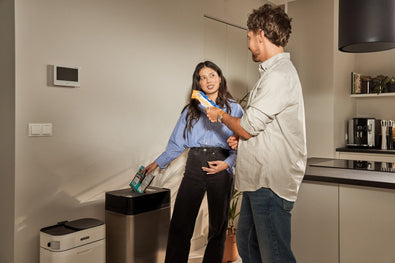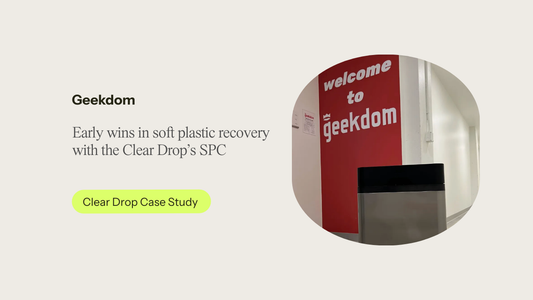ZeroTrash® Revolution Blog Blog
Explore articles on recycling, waste management and sustainable habits by category

Clear Drop: how we’re revolutionizing home waste management
Read
How the Shaw Institute Successfully Started to ...
The Shaw Institute in Blue Hill, Maine, is a respected nonprofit research organization studying the impact of contaminants, including PFAS chemicals and microplastics — on human and environmental health. Their...
Case studyСorporate sustainability
How the Shaw Institute Successfully Started to Recycle Laboratory Soft Plastic Waste for the First Time with SPC
The Shaw Institute in Blue Hill, Maine, is a respected nonprofit research organization studying the impact of contaminants, including PFAS chemicals and microplastics — on human and environmental health. Their work is regularly published in leading scientific journals and covered by international media. The institute also operates an Environmental Education Center (EEC) featuring aquariums, marine mammal skeletons, and hands-on ocean exploration exhibits. Like most laboratories, the Shaw Institute generates significant quantities of clean polyethylene (PE) and polypropylene (PP) soft plastic waste from daily research operations — including packaging from lab tools, sampling supplies, and delivery materials. According to the U.S. EPA, most municipal programs do not accept soft plastics, meaning nearly all of this material historically went to landfills. To address this challenge, the Shaw Institute became one of the first research laboratories in the U.S. to pilot the Clear Drop Soft Plastic Compactor (SPC) — an on-site, lab-friendly solution designed specifically for soft plastic recycling. UNEP research highlights how important innovations like this are for managing flexible plastics responsibly. Why the Shaw Institute Chose the Clear Drop SPC Before implementing the SPC, staff had no practical way to recycle common laboratory soft plastics, including: polyethylene baggies and protective films bubble wrap and cushioning packaging sterile wrap and supply pouches other clean PE and PP packaging from lab operations “We were looking for proven technology that could help us deal with the soft plastic problem in our lab and beyond,” explains Dr. Charlie Rolsky, Executive Director and Lead Research Scientist. “We're excited to pilot Clear Drop’s SPC device as part of our 2025 internal sustainability efforts. It offers a much-needed solution for improving our ability to recycle the soft plastic waste generated by our lab work.” The Clear Drop SPC was selected because it: compresses clean soft plastics into dense, stackable blocks ready for certified recyclers requires minimal space and no heat or chemicals works precisely with PE and PP waste produced in labs supports the institute’s mission to reduce plastic pollution and “practice what they preach” A detailed technical explanation of the device’s operation is available here. Implementation and First-Month Results The SPC was installed directly inside the laboratory — the primary source of soft plastic waste. Staff received training on cleaning, sorting, and feeding materials into the compactor. The installation required no facility modifications and integrated smoothly into daily workflows. In the first month alone: 6 dense blocks of clean soft plastic waste were compacted and prepared for recycling 5 staff members plus several volunteers became regular SPC users The device operated safely and consistently in an active research environment The SPC quickly became an effective tool for reducing landfill-bound laboratory plastics and improving internal sustainability practices. Expansion Beyond the Lab Although the initial goal was laboratory waste reduction, the pilot expanded naturally as staff recognized the device’s capabilities: Soft plastics from the Environmental Education Center (EEC) are now collected and processed Employees began bringing clean PE/PP soft plastics from home Once per week, the SPC is moved to a public EEC exhibit, where visitors can observe the compression process and learn about soft plastic circularity This turned the SPC into both a practical waste-management device and a hands-on educational resource, supporting the institute’s public outreach mission. Early Community Interest (Next-Phase Potential) Building on the success of the internal pilot, the Shaw Institute is now exploring the idea of serving as a temporary community drop-off point where local residents can bring clean soft plastics for guaranteed recycling. While still in planning, this potential expansion aligns naturally with visitor engagement and mirrors other pilot models implemented by Clear Drop. Key Benefits Realized by the Shaw Institute First-ever ability to recycle laboratory soft plastic waste on-site Significant progress toward near-zero-waste lab and facility operations Strong alignment between the institute’s research mission and daily sustainability practices A new educational tool demonstrating real-world soft plastic recycling Proven, low-maintenance technology suitable for research organizations of any size The Shaw Institute pilot demonstrates that even small scientific institutions can successfully implement soft plastic recycling programs with the right equipment. For laboratories seeking a reliable, lab-safe, ready-to-deploy solution, the Clear Drop SPC offers measurable results and immediate environmental impact. Explore the SPC here.

How Geekdom sparked early wins in soft plastic ...
Geekdom is a cornerstone of San Antonio’s startup and innovation ecosystem. Spread across four floors in a prominent downtown building, it houses approximately 40 startups and plays host to a...
Case studyСorporate sustainability
How Geekdom sparked early wins in soft plastic recovery with the Clear Drop's SPC
Geekdom is a cornerstone of San Antonio’s startup and innovation ecosystem. Spread across four floors in a prominent downtown building, it houses approximately 40 startups and plays host to a steady calendar of events: game jams, hackathons, seminars, and tech conferences. It’s the epicenter of the city’s entrepreneurial and venture community. Like many innovation hubs, Geekdom grapples with high volumes of everyday office & food packaging waste. Prior to the pilot, there was no structured process to recover or reduce this plastic waste stream. Pilot goals: Understand employee interest and engagement around soft plastic recycling Measure volume and speed of soft plastic accumulation Evaluate SPC’s role in supporting Geekdom’s broader sustainability and community values Approach Geekdom saw potential in the SPC’s ability to foster a shared community action around sustainability. The device was installed in a common area used by many different startup teams throughout the day, encouraging collaborative stewardship. The pilot was supported by custom signage near the kitchen/break room, table tents on community tables, and direct email outreach to all staff and tenants coordinated with Geekdom’s operations team. Geekdom staff even made their own signage :) Metrics: 1 SPC deployed 2 full soft plastic blocks created in under 2 months Employee participation was tracked qualitatively through conversations and visual observation Improvements are now in the works after receiving awesome critical feedback from staff on signage and the device’s instant recognizability as a recycling device. Materials inserted: Mailers and plastic wrappers from startup equipment Grocery bags, sandwich wrappers, and snack packaging from shared lunches Miscellaneous soft film plastics found around events “As someone who loves to recycle I want this in my home! It’s so easy to use, and gives me a way to recycle what is normally trash” - Julez Perez. Summary Geekdom views the SPC not just as a waste solution but as a community-building tool. In just two weeks, tenants filled a full block with soft plastics, demonstrating both engagement and the real waste footprint of a single floor. The operations team is now in deeper conversations with ClearDrop to potentially expand the pilot to multiple floors. Their slow-roll strategy allows for organic feedback and culture-based insights, helping refine messaging and product design while reinforcing Geekdom’s mission to lead in innovation and sustainability.

How Trinity University advanced soft plastic re...
Flexible plastic waste is one of the most persistent challenges on college campuses. From snack wrappers to shipping film used in media facilities, most soft plastics end up in landfills....
Case studySoft plasticWaste managementСorporate sustainability
How Trinity University advanced soft plastic recycling with the SPC
Flexible plastic waste is one of the most persistent challenges on college campuses. From snack wrappers to shipping film used in media facilities, most soft plastics end up in landfills. Trinity University partnered with Clear Drop to pilot the Soft Plastic Compactor (SPC) inside the Richardson Communications Center — a space connecting academics, student media, and public programming — to test how a simple visibility shift could spark real sustainability participation. Trinity University, a nationally ranked liberal arts institution in San Antonio, Texas, enrolls approximately 2,600 students and maintains a student-to-faculty ratio of roughly 8:1. The university is known for its academic rigor, outstanding alumni outcomes, and architecturally significant campus. Trinity consistently ranks among the top liberal arts colleges in the country and holds the distinction of being the number one liberal arts university in Texas. Within the Dorothy A. and James W. Laurie Auditorium complex lies the Richardson Communications Center, home to the university’s Department of Communication and KRTU-FM (Jazz 91.7). KRTU is a premier jazz and alternative radio station serving the greater Southwest — a campus and community hub where media production, learning, and cultural programming intersect. Laurie Auditorium itself is a 2,700-seat venue that hosts a wide range of events, from academic lectures and commencement ceremonies to public performances, community discussions, and special guest visits. Its high visibility and diverse audience made it an ideal site to explore a new sustainability initiative. Project goals The goal of this pilot was to understand how the SPC performs in a high-traffic environment that brings together: Students in media and communication programs Faculty and staff working daily in shared spaces KRTU-FM hosts, volunteers, and production teams Visitors and community members attending events Guest speakers and partners engaged in cultural programming This allowed Trinity to evaluate not only the waste reduction impact but also communication strategies that make sustainability efforts feel accessible and rewarding. Soft Plastic Compactor solution The SPC was installed in the Communication Department break room — a location integrated into daily student and staff routines within the Laurie Auditorium complex. Clear, friendly instructions helped everyone quickly understand what types of plastics belong in the device and why this matters for recycling outcomes. Instead of soft plastics piling up in bins or heading to landfill, the SPC turned them into compact blocks ready for recycling through Clear Drop’s partner network. The device became a conversation starter, reinforcing that taking part in sustainability can be practical, fast, and even satisfying. “Seeing wrappers and film compact in seconds is cathartic — it normalizes sustainable behavior.” — Dr. Althea Delwiche, Professor & Dept. Chair SPC use case Primary location Shared Communication Department break room within the Laurie Auditorium complex. Key user groups Communication faculty and administrative staff Students and student media workers KRTU DJs, station employees, and volunteers Event guests and visiting speakers Common soft plastic inputs Snack wrappers and drink packaging Film wrap from studio and tech deliveries Mailers and protective packaging for radio operations Plastics from hospitality support for events This variety of inputs revealed the types of soft plastic generated in an interdisciplinary learning and production environment, while also showing how easily different user groups could adopt the SPC as part of their daily routines. Early outcomes Increased awareness of soft plastic recycling among students and staff Higher engagement from users who had never recycled soft plastics before More visible sustainability action in a shared, high-traffic space Successful testing of messaging and signage formats for wider roll-out The pilot showed how placing the SPC where people naturally interact — not hidden behind facility doors — drives adoption from day one. Findings and new collaboration perspectives This pilot demonstrated that the SPC can thrive in educational environments where media production, learning, and public interaction overlap. Trinity University continues evaluating broader expansion across campus departments. Clear Drop is exploring additional installations to support sustainability goals tied to student engagement, waste reduction, and campus innovation. Colleges play a key role in shaping habits that last a lifetime. By making soft plastic recycling easy and visible, Trinity is helping build those habits now — right at the source of waste generation. Bring Soft Plastic Recycling to Your Campus Clear Drop® partners with universities to reduce flexible plastic waste in student and staff spaces with measurable results. Contact our team to start a pilot at your campus: https://onecleardrop.com/pages/for-business

How one office building pilot became a model fo...
Commercial buildings generate a large share of soft plastic waste — from deliveries, shipments, food packaging, and office supplies — most of which ends up in landfills. This case study...
Case studyWaste managementСorporate sustainability
How one office building pilot became a model for smarter soft plastic waste reduction
Commercial buildings generate a large share of soft plastic waste — from deliveries, shipments, food packaging, and office supplies — most of which ends up in landfills. This case study shows how one multi-tenant office building piloted the Soft Plastic Compactor (SPC) and proved that even a small shift in workplace waste handling can significantly reduce volume, improve recycling rates, and elevate ESG performance. In the heart of a major U.S. city, San Antonio, a 10-story commercial office building with up to 30 tenant companies took a step toward smarter sustainability. The building’s management sought an effective, hands-on solution to deal with soft plastic waste generated by significant traffic, regular deliveries, and daily office activity. Until recently, the entire building's soft plastic went straight into general waste bins and, inevitably, landfills. Recognizing this recycling gap, the management team agreed to test a new sustainable approach by piloting the Soft Plastic Compactor (SPC), a first-of-its-kind device designed specifically to deal with flexible plastics at the point of disposal. The goal: reducing waste and changing behavior Unlike other recycling efforts, soft plastics — such as mailers, wrappers, and packaging — are often overlooked. They’re lightweight, shapeless, and notoriously hard to recycle. Most commercial buildings lack the infrastructure to separate or reallocate these materials. This pilot focused not only on waste reduction but also on behavioral change — testing how a shared, high-traffic environment would respond to a new sustainability intervention. The experience also helped identify how to better communicate and position the Soft Plastic Compactor (SPC) within a commercial setting. “It’s great to finally see a solution targeting the soft plastic waste we all know ends up in the trash. It's sparked some good conversations among tenants already.” — Tenant feedback, Week 1 The plan: installing an SPC The SPC was installed in a central public area frequented by employees and service staff. Clear signage explained what the device was, what types of plastics it accepts, and why it mattered. There were no lengthy training sessions — the UX was intuitive enough for immediate adoption. Initial reactions and feedback Within days, the building began to see early signs of success. Staff and tenants engaged with the machine organically and showed increased curiosity about soft plastic waste, sustainability, and recycling behavior. Some initial user feedback helped identify opportunities for improvement — such as screen readability and UX ergonomics — which will inform updates for future pilots. “We didn’t know what to expect, but people started asking about the machine almost immediately. It feels like something new is possible here.” — Building staff comment SPC’s immediate impact The SPC became a learning lab for the building’s management and Clear Drop. The team tracked how tenants used the machine, what signage worked best, and what kinds of plastics were being collected. From day one, tenants fed a variety of flexible plastics into the SPC, including: Food wrappers and grocery bags Shipping mailers and packaging film Bubble wrap and soft protective materials With the SPC positioned in a central high-traffic area, the team also evaluated responsibility and workflow — such as who should empty the device and how often, and what internal infrastructure a multi-tenant building needs for successful adoption. Results: SPC minimized plastic waste and spotlighted sustainability innovation The pilot demonstrated that even modest behavioral shifts can drive meaningful sustainability gains in shared office environments. The SPC reduced soft plastic waste volume, improved recyclability, and sparked visible tenant engagement. Management now views the SPC as a valuable sustainability amenity — a practical way to demonstrate commitment to environmental responsibility, innovation, and accountability. The building’s team is evaluating future SPC expansions as part of broader ESG initiatives and corporate sustainability improvements. Why SPC Works for Offices and Multi-Tenant Buildings Decentralized soft plastic disposal at the point of waste generation Clear signage and simple UX encourage employee engagement Reduces plastic waste volume by up to 90% Enables real recycling through Clear Drop partner network Strengthens visible sustainability commitments to tenants and clients Make Your Office Sustainability Visible and Actionable The Clear Drop® Soft Plastic Compactor (SPC) transforms flexible plastic waste into compact 12×8×4-inch blocks — easy to store, ship, and recycle through our partners. Learn more about SPC for business: https://onecleardrop.com/pages/for-business Frequently Asked Questions How does the SPC improve recycling for commercial buildings? It prepares flexible plastics for real recycling by compacting them into dense, shape-preserving blocks that can be collected and processed by Clear Drop partners. How often does the SPC need to be emptied? Typically once per month in an office environment, depending on the volume of plastic collected. What types of plastics can the SPC handle? Most flexible plastics including shipping mailers, garment bags, bubble wrap, and soft packaging film. PVC and polystyrene are not accepted. What sustainability benefits does the SPC provide businesses? The SPC reduces waste volume by up to 90%, decreases landfill contribution, improves ESG alignment, and boosts tenant or employee engagement in sustainability.

How Eduardo's Bridal & Tuxedo reduced soft plas...
Garment retail businesses rely heavily on flexible plastic packaging to protect inventory. But once gowns and tuxedos are unwrapped, that plastic becomes costly, bulky waste. Eduardo’s Bridal & Tuxedo, a...
Case studySoft plasticСorporate sustainability
How Eduardo's Bridal & Tuxedo reduced soft plastic waste volume by 90% with the SPC
Garment retail businesses rely heavily on flexible plastic packaging to protect inventory. But once gowns and tuxedos are unwrapped, that plastic becomes costly, bulky waste. Eduardo’s Bridal & Tuxedo, a family-owned formalwear retailer in San Antonio, partnered with Clear Drop to turn a previously ignored waste stream into a meaningful sustainability win. With the Soft Plastic Compactor (SPC), they now reduce soft plastic volume by nearly 90% and send compacted blocks into real recycling streams instead of landfills. Challenging soft plastic packaging waste Eduardo’s Bridal & Tuxedo has served customers for more than 35 years – from wedding gowns to tuxedos and quinceañera dresses. However, every rental garment arrives wrapped in soft plastic film: shipping wrap, protective covers, dry-cleaning bags, accessory packaging. Previously, this lightweight but bulky material was bagged and sent to landfill. Access to soft plastic recycling in the region was limited, and traditional recycling haulers did not accept film plastics. The result: overflowing bins, higher waste removal costs, and a missed opportunity to support sustainability goals valued by customers and employees, as well as to participate in structured business recycling programs. Solution Clear Drop installed the SPC directly in the back-room storage area, where plastic waste is generated. Staff received quick onboarding with simple signage so the workflow required no habit change. Soft plastics are now collected in one place and compacted into dense blocks using the SPC’s patented surface-softening technology. These space-saving blocks are stored cleanly, picked up monthly, and processed by Clear Drop’s recycling partners – ensuring the waste remains in a circular economy. “It was easy to get the team onboard. We generate so much plastic packaging just unboxing dresses. It was great to finally have something to do with it besides toss it.” — Laura D., store manager. The Soft Plastic Compactor (SPC) quickly became part of the daily routine, turning loose plastic into tidy, labeled blocks that fit seamlessly into existing back-of-house processes. Soft Plastic Compactor use case During the two-month pilot, the team collected garment wrap, shrink film from shipments, and dry-cleaning bags. Instead of piling up loose in trash bags, these materials became stackable, labeled SPC blocks ready for real recycling. No disruption to busy fitting-room workflow No additional storage needs for bulky waste Clear visibility of sustainability in action for staff and customers “It’s small, quiet, and honestly kind of satisfying to use. Makes us feel like we’re part of the solution, not just the problem.” — Sylvia B., sales manager. Results Eduardo’s Bridal & Tuxedo reduced soft plastic waste volume by approximately 90%, freeing valuable back-room space and lowering waste handling costs. The success of this pilot has led the business to consider expanding the SPC to its second location, along with customer-facing messaging that highlights their sustainability efforts. Their case shows that even a traditionally waste-intensive service business can make measurable progress with simple, scalable technology like the Soft Plastic Compactor (SPC). Bring Waste Reduction to Your Business See how the SPC can simplify soft plastic management and support your corporate sustainability goals. Learn more for business Explore SPC for your operations Frequently Asked Questions How much waste volume can the SPC reduce? On average, businesses see up to a 90% reduction in soft plastic volume depending on monthly usage and the types of packaging handled. What types of plastics can the SPC process? The SPC processes most soft film plastics, including garment bags, shipping wrap, bubble wrap, plastic mailers, and packaging film. PVC and PS are excluded and should not be placed in the device. How does pickup or recycling work for businesses? Compacted blocks are stored on-site and collected based on a program tailored to each location, ensuring all recyclable soft plastics enter the correct processing stream through Clear Drop’s recycling partners. Does the SPC require changes in workflow? No. The SPC integrates easily into typical back-of-house processes and requires minimal staff time, so teams can keep focusing on customers while improving sustainability performance.

